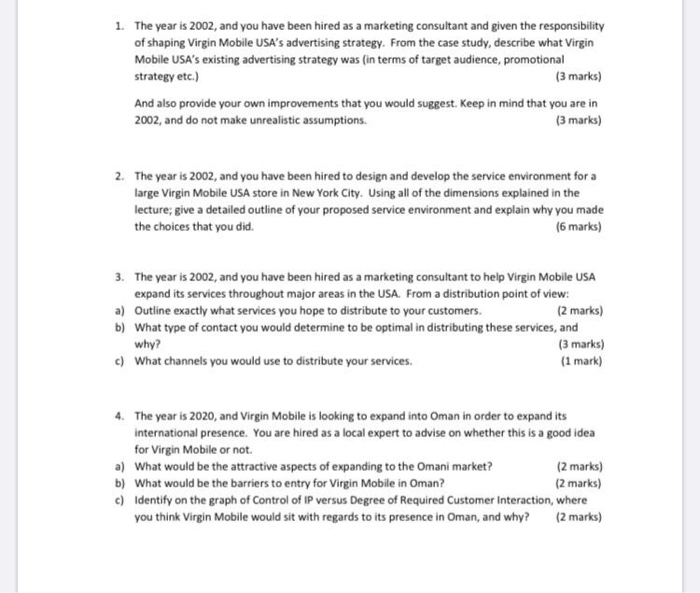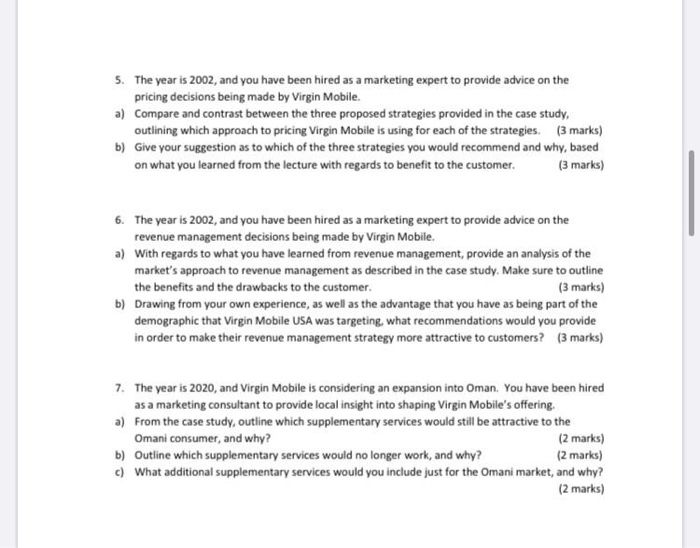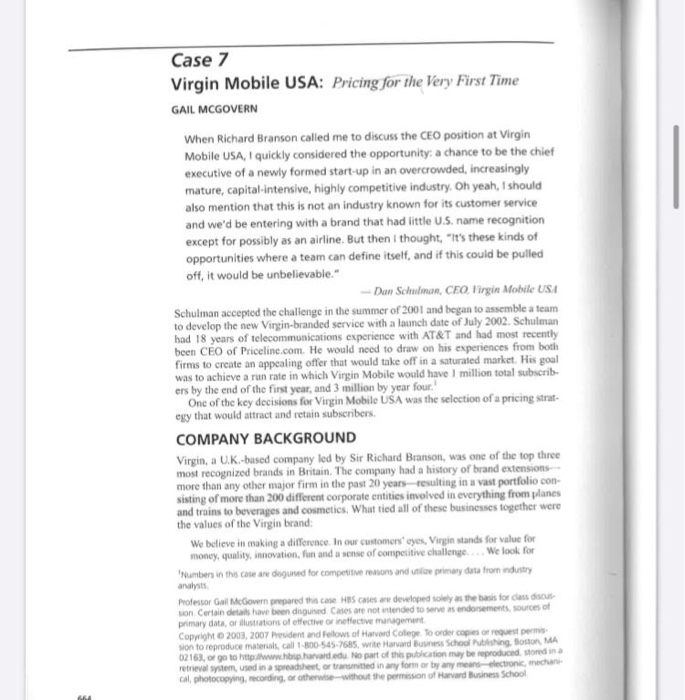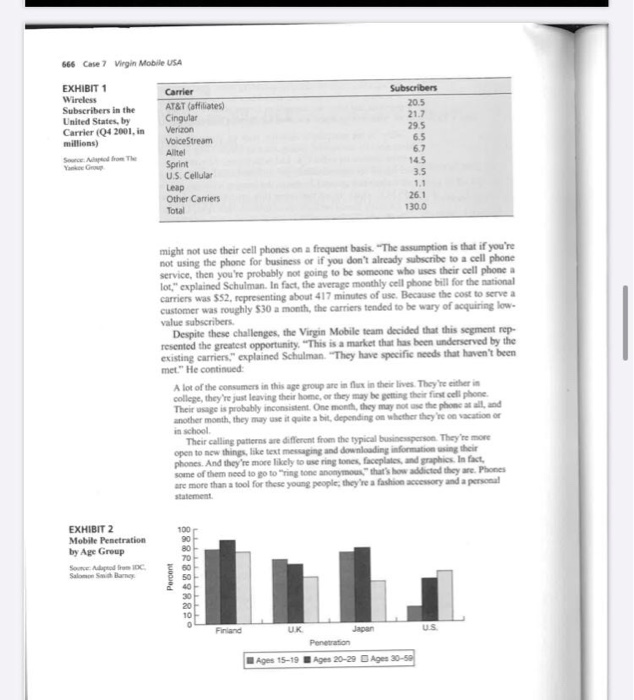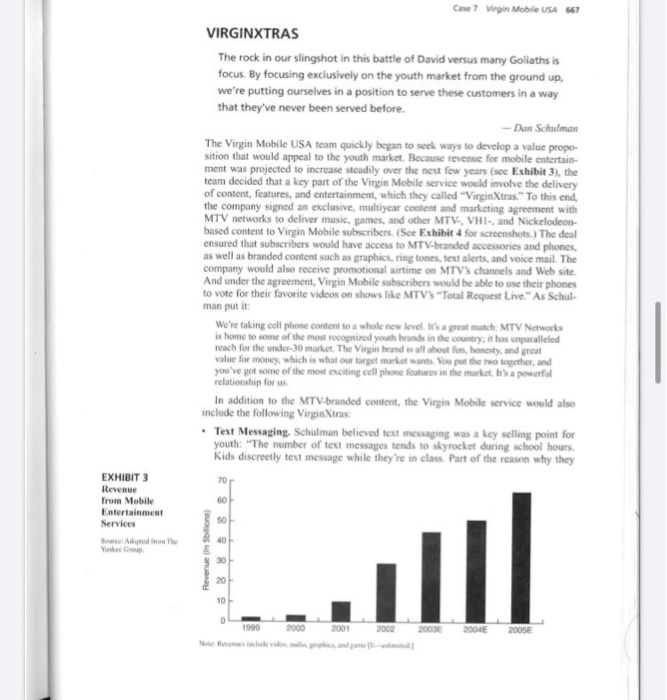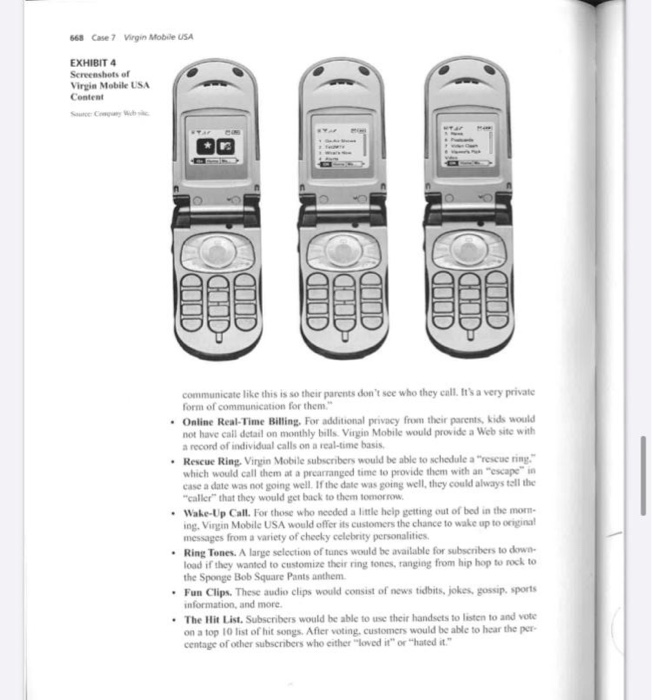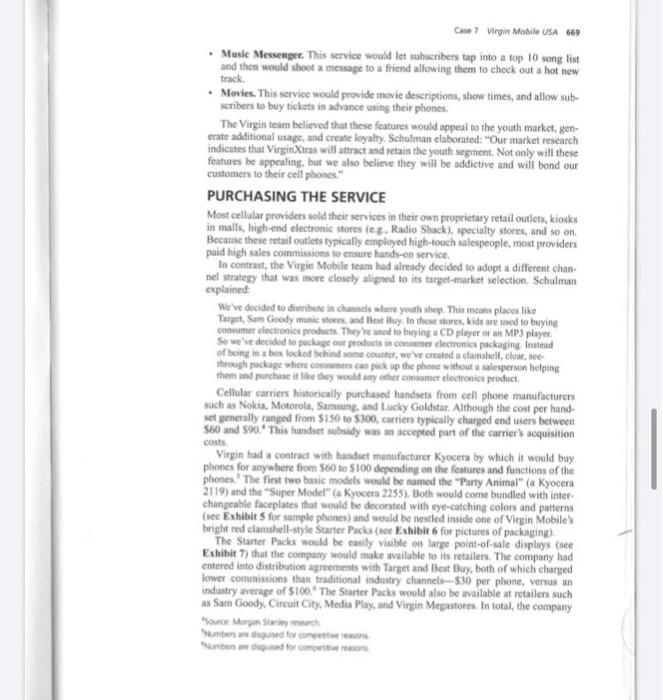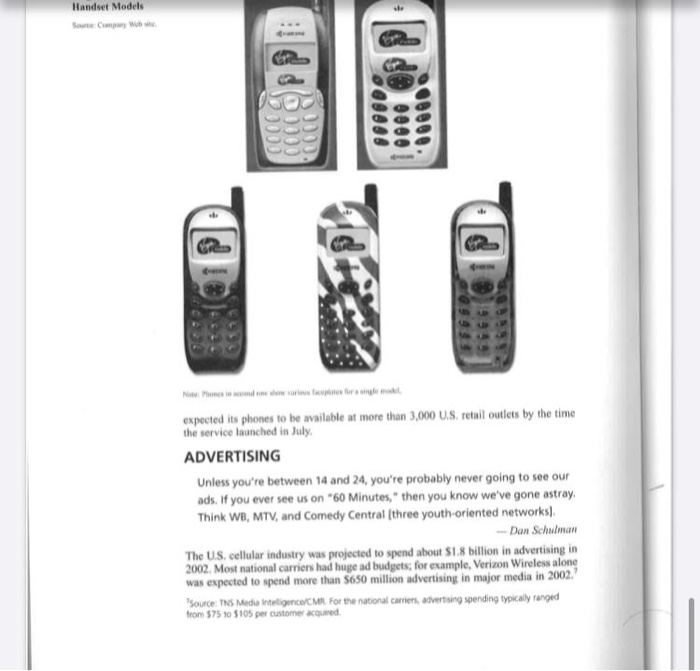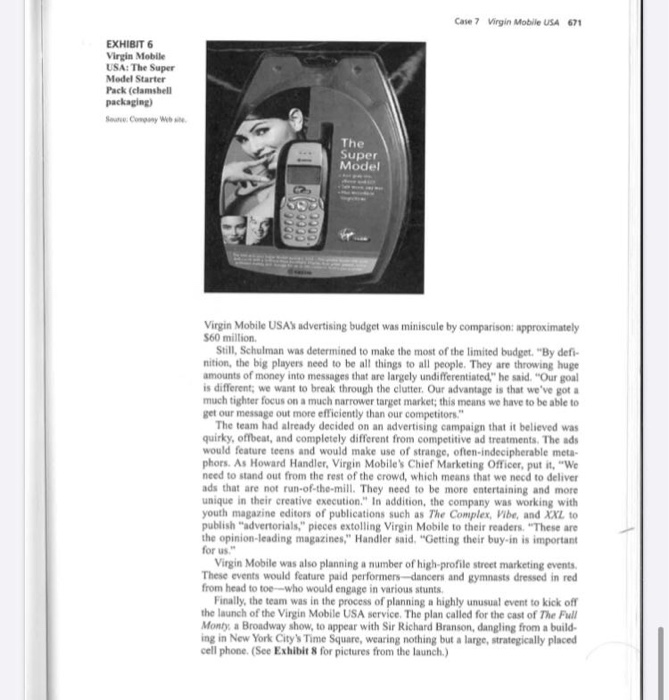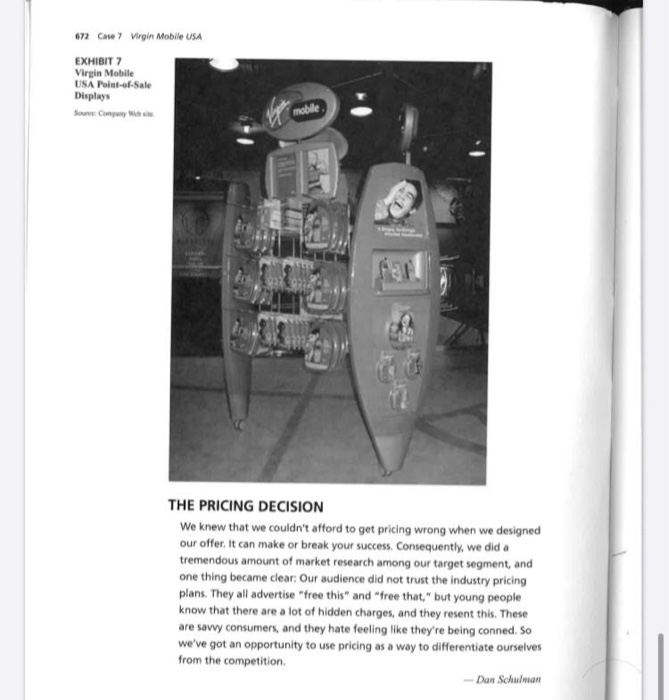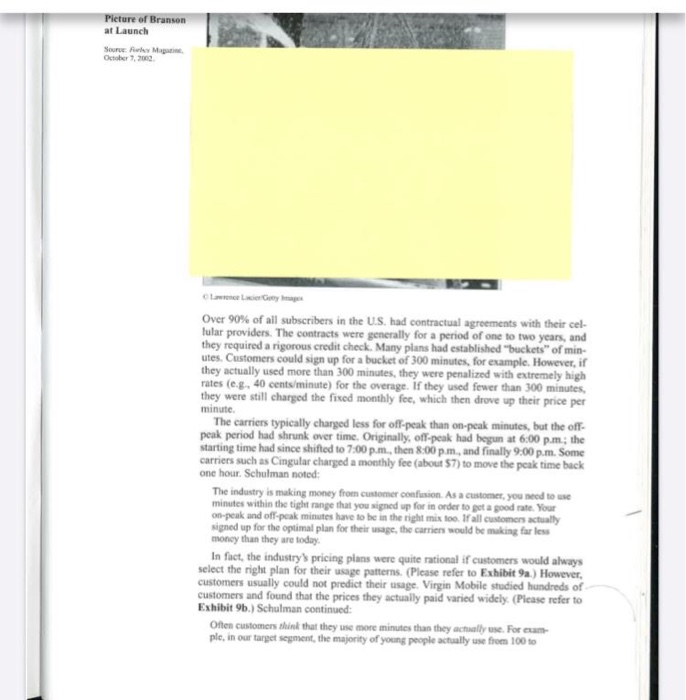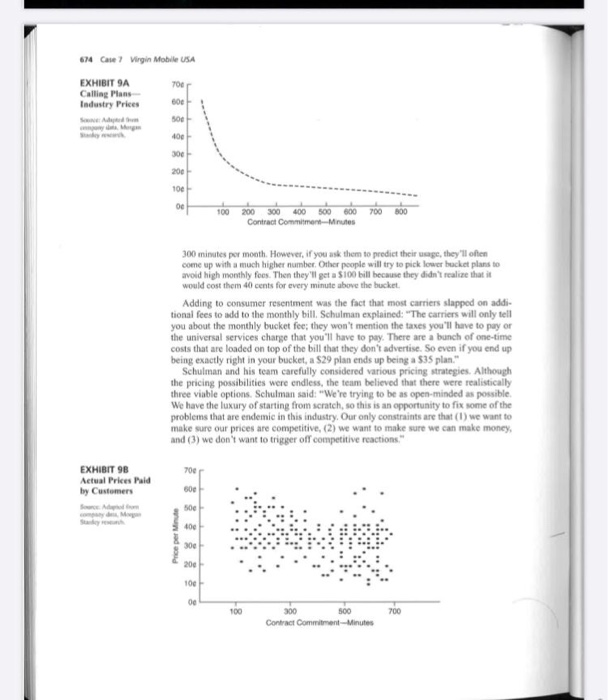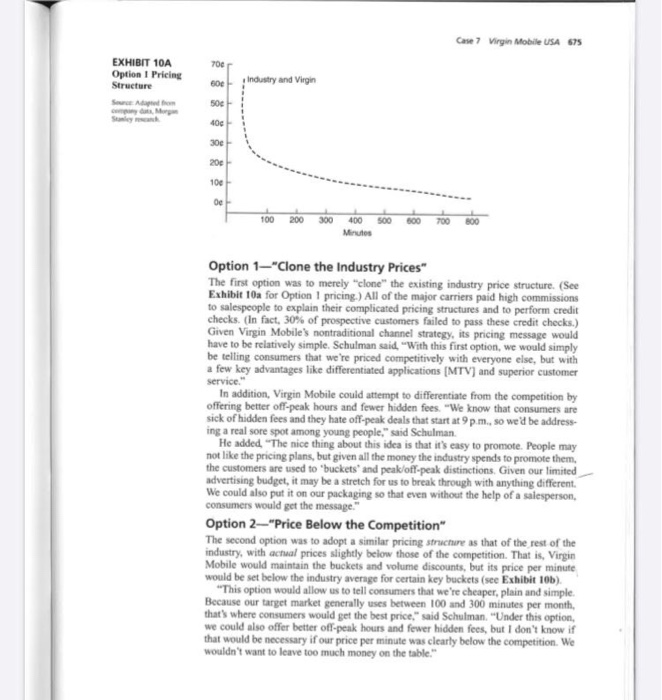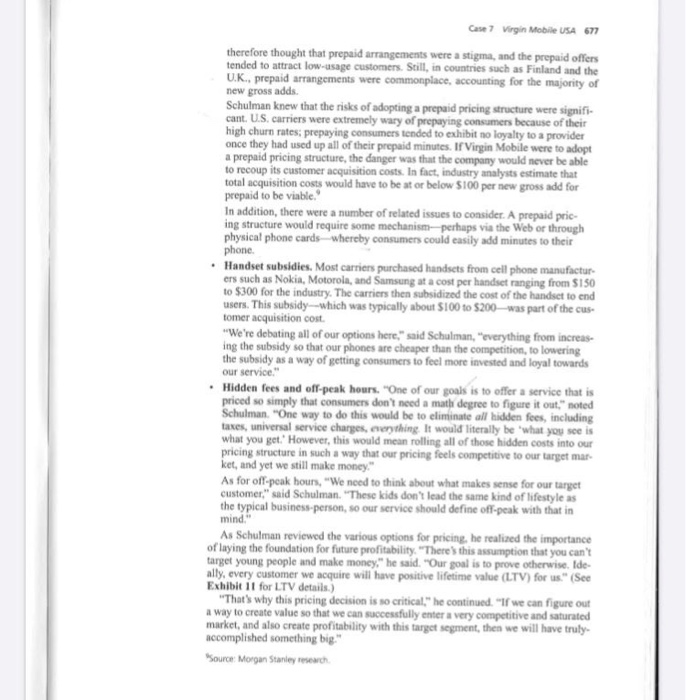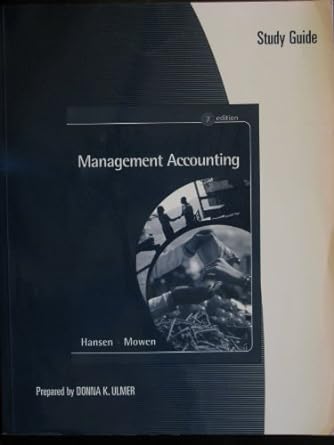1. The year is 2002, and you have been hired as a marketing consultant and given the responsibility of shaping Virgin Mobile USA's advertising strategy. From the case study, describe what Virgin Mobile USA's existing advertising strategy was (in terms of target audience, promotional strategy etc.) (3 marks) And also provide your own improvements that you would suggest. Keep in mind that you are in 2002, and do not make unrealistic assumptions. (3 marks) 2. The year is 2002, and you have been hired to design and develop the service environment for a large Virgin Mobile USA store in New York City. Using all of the dimensions explained in the lecture; give a detailed outline of your proposed service environment and explain why you made the choices that you did (6 marks) 3. The year is 2002, and you have been hired as a marketing consultant to help Virgin Mobile USA expand its services throughout major areas in the USA. From a distribution point of view: a) Outline exactly what services you hope to distribute to your customers. (2 marks) b) What type of contact you would determine to be optimal in distributing these services, and why? (3 marks) c) What channels you would use to distribute your services. (1 mark) 4. The year is 2020, and Virgin Mobile is looking to expand into Oman in order to expand its international presence. You are hired as a local expert to advise on whether this is a good idea for Virgin Mobile or not. a) What would be the attractive aspects of expanding to the Omani market? (2 marks) b) What would be the barriers to entry for Virgin Mobile in Oman? (2 marks) c) Identify on the graph of Control of IP versus Degree of Required Customer Interaction, where you think Virgin Mobile would sit with regards to its presence in Oman, and why? (2 marks) 5. The year is 2002, and you have been hired as a marketing expert to provide advice on the pricing decisions being made by Virgin Mobile. a) Compare and contrast between the three proposed strategies provided in the case study, outlining which approach to pricing Virgin Mobile is using for each of the strategies. (3 marks) b) Give your suggestion as to which of the three strategies you would recommend and why, based on what you learned from the lecture with regards to benefit to the customer. (3 marks) 6. The year is 2002, and you have been hired as a marketing expert to provide advice on the revenue management decisions being made by Virgin Mobile. a) with regards to what you have learned from revenue management, provide an analysis of the market's approach to revenue management as described in the case study. Make sure to outline the benefits and the drawbacks to the customer. (3 marks) b) Drawing from your own experience, as well as the advantage that you have as being part of the demographic that Virgin Mobile USA was targeting, what recommendations would you provide in order to make their revenue management strategy more attractive to customers? (3 marks) 7. The year is 2020, and Virgin Mobile is considering an expansion into Oman. You have been hired as a marketing consultant to provide local insight into shaping Virgin Mobile's offering a) From the case study, outline which supplementary services would still be attractive to the Omani consumer, and why? (2 marks) b) Outline which supplementary services would no longer work, and why? (2 marks) c) What additional supplementary services would you include just for the Omani market, and why? (2 marks) Case 7 Virgin Mobile USA: Pricing for the Very First Time GAIL MCGOVERN When Richard Branson called me to discuss the CEO position at Virgin Mobile USA, I quickly considered the opportunity, a chance to be the chief executive of a newly formed start-up in an overcrowded, increasingly mature, capital-intensive, highly competitive industry. Oh yeah, I should also mention that this is not an industry known for its customer service and we'd be entering with a brand that had little U.S. name recognition except for possibly as an airline. But then I thought, "It's these kinds of opportunities where a team can define itself, and if this could be pulled off, it would be unbelievable." Dan Schulman, CEO, Virgin Mobile USA Schulman accepted the challenge in the summer of 2001 and began to assemble a team to develop the new Virgin-branded service with a launch date of July 2002. Schulman had 18 years of telecommunications experience with AT&T and had most recently been CEO of Priceline.com. He would need to draw on his experiences from both firms to create an appealing offer that would take off in a saturated market. His goal was to achieve a run rate in which Virgin Mobile would have 1 million total subscrib- ers by the end of the first year, and 3 million by year four. One of the key decisions for Virgin Mobile USA was the selection of a pricing strat egy that would attract and retain subscribers COMPANY BACKGROUND Virgin, a U.K.-based company led by Sir Richard Branson, was one of the top three most recognized brands in Britain. The company had a history of brand extensions more than any other major firm in the past 20 years-resulting in a vast portfolio con sisting of more than 200 different corporate entities involved in everything from planes and trains to beverages and cosmetics, What tied all of these businesses together were the values of the Virgin brand: We believe in making a difference. In our customers' eyes, Virgin stands for value for money, quality, innovation, fun and a sense of competitive challenge. We look for Numbers in the case a doguned for competitive renons and for primary data from industry analysis Professor Gal McGovern prepared the cases are developed to as the basis for classic son Certain details have been disguised Cases are not intended to serve as endorsements primary data, or stations of effective or infective management Copyright 2003, 2007 President and follows of Harvard College to order copies or request permis sion to reproduce materials call 1-800-545-7685, wite Harvard Business School Publishing, Boston, MA 02163, or go to www.savad. No part of this publication may be reproduced, stored in a retrieval system used in a spreadsheet or transmitted in any form or by any meansetron, mechan cal, photocopying, recording, or otherwise without the permission of Harvard Business School Care? Virgin Mobile USA opportunities where we can offor something better, fresher and more valuable, and we see them. We often move intoarcas where the customer has traditionally received a poor deal, and where the competition is complacent... We are pro-active and quick to act, often leaving bigger and more cumbersome organizations in our wake. Many of the company ventures, such as Virgin Music Group, had proven to be phenomenally successful others, such as Virgin Cola, had resulted in failure. Virgin cellular operations in the UK. had been among the company's success stories - Virgin had signed up approximately 2.5 million customers in just three years. The venture had broken new ground by being the country's first mobile virtual network operator (MVNO), which meant that rather than investing in and running a network in-house, the company leased network space from another firm, Deutsche Telekom, In Singapore, however, the story had been different. There, the company's cellular service-joint venture with Singapore Telecommunications had run into difficul ties, attracting fewer than 30,000 subscribers after its launch in October 2001. The Sin gapore MVNO had recently shut its doors, and although both partners had agreed that the market had been too saturated to sustain a new entrant, some analysts had offered another explanation for the failure: Virpinship and trendy positioning had failed to strike a chord in the Singapore market. Despite this setback, Virgin had forged ahead with its plans to launch a wireless phone service in the US. Utilizing the MVNO model once again, the company had entered into a 50-50 joint venture with Sprint in which Virgin Mobile USAS services would be hosted on Sprint PCS network (Sprint was in the process of updating its network and increasing its capacity, so that it had ample capacity to allow for additional users.) Under the agreement, Virgin Mobile would purchase minutes from Sprint on an as-used basis "The nice thing about this model is that we don't have to worry about huge fixed costs or the physical infrastructure," said Schulman. "We can focus on what we do best-understanding and meeting customer needs." THE CROWDED CELLULAR MARKET: IDENTIFYING A NICHE The team leading Virgin Mobile USA was scutely aware of the overcrowded nature of the mobile communications industry in the United States. At the end of 2001, the U.S. had six national carriers and a number of regional and affiliate providers. Indus try penetration was close to 50% with about 30 million subscribers, and the market was considered to have reached maturity. (Please see Exhibit for subscribers by carrier) Among consumers aged 15 to 29, however, penetration was significantly lower, and the growth rate among this demographic was projected to be robust for the next five years. (Please see Exhibit 2 for growth rates) Still, as Schulman observed. "The big players haven't targeted this segment." One reason was that young consumers often had poor credit quality. "These are people who don't necessarily have credit cards and often don't pass the credit checks that the cel- lular contracts require." Schulman noted In addition, in an industry in which the average cost to acquire a customer was roughly $370, many carriers did not believe it was worth acquiring consumers who Source Company Website Source: Strategis Group 666 Case? Virgin Mobile USA EXHIBIT 1 Wireless Subscribers in the United States, by Carrier (Q4 2001, in millions) Carrier AT&T (affiliates) Cingular Version VoiceStream Altel Sprint U.S. Cellular Leap Other Carriers Total Subscribers 205 21.7 295 65 6.7 145 3.5 26.1 130.0 might not use their cell phones on a frequent basis. The assumption is that if you're not using the phone for business or if you don't already subscribe to a cellphone service, then you're probably not going to be someone who uses their cell phone a lot," explained Schulman. In fact, the average monthly cell phone bill for the national carriers was 552, representing about 417 minutes of use. Because the cost to serve a customer was roughly $30 a month, the carriers tended to be wary of acquiring low- value subscribers Despite these challenges, the Virgin Mobile team decided that this segment rep resented the greatest opportunity. This is a market that has been underserved by the existing carriers," explained Schulman. "They have specific needs that haven't been met." He continued A lot of the consumers in this age group are in flux in their lives. They're either in college, they're just leaving their home or they may be getting their first cell phone. Their usage is probably inconsistent One month, they may not use the phone at all, and another month, they may use it quite a bit, depending on whether they're on vacation or in school Their calling patterns are different from the typical business. They're more open to new things, like text messaging and downloading information using their phones. And they're more likely to use ringtone, faceplates and graphics. In fact, some of them need to go to ring tone anonymous" that's how addicted they are Phones are more than a tool for these young people, they're a fashion accessory and a personal statement EXHIBIT 2 Mobile Penetration by Age Group SADC Salomon Sine Percent 8888888888 Finland UK US Japan Penetration Age 20-29 Agen 30-50 Ages 15-19 Case? Virgin Mobile USA 667 VIRGINXTRAS The rock in our slingshot in this battle of David versus many Goliaths is focus. By focusing exclusively on the youth market from the ground up. we're putting ourselves in a position to serve these customers in a way that they've never been served before. -Dan Schulman The Virgin Mobile USA team quickly began to seek ways to develop a value propo sition that would appeal to the youth market. Because revenue for mobile entertain ment was projected to increase steadily over the next few years (see Exhibit 3), the team decided that a key part of the Virgin Mobile service would involve the delivery of content, features, and entertainment, which they called "VirginXtras." To this end, the company signed an exclusive, multiyear content and marketing agreement with MTV networks to deliver music, games, and other MTK, VH and Nickelodeon based content to Virgin Mobile subscribers. (See Exhibit 4 for screenshots.) The deal ensured that subscribers would have access to MTV-branded accessories and phones as well as branded content such as graphics, ringtones, text alerts, and voice mail. The company would also receive promotional airtime on MTV channels and Web site And under the agreement, Virgin Mobile subscribers would be able to use their phones to vote for their favorite videos on shows like MTV3 "Total Request Live." As Schul- man put it: We're taking cell phone content to a whole new level. It's a great match: MTV Networks is home to some of the most recognized youth brands in the country, it has unparalleled reach for the under-30 market. The Virgin brand is all about fun, honesty, and great value for money, which is what our target market want you put the two together, and you've got some of the most exciting cell phone features in the market. It a powerful relationship for us In addition to the MTV-branded content, the Virgin Mobile service would also include the following Virgin Xtras Text Messaging Schulman believed text messaging was a key selling point for youth: "The number of text messages tends to skyrocket during school hours Kids discreetly text message while they're in class. Part of the reason why they 70 60 EXHIBIT 3 Revenue from Mobile Entertainment Services Wom Ver Revenue in Sillions) $30 20 10 1999 2000 2001 2002 2003E 2004 2005E 668 Case 7 Virgin Mobile USA EXHIBIT 4 Screenshots of Virgin Mobile USA Content Source DID GHIDI CUID OOD QUOD ODD 090 communicate like this is so their parents don't see who they call. It's a very private form of communication for them." Online Real-Time Billing. For additional privacy from their parents, kids would not have call detail on monthly bills Virgin Mobile would provide a Web site with a record of individual calls on a real-time basis Rescue Ring. Virgin Mobile subscribers would be able to schedule a "rescue ting." which would call them at a prearranged time to provide them with an "escape" in case a dute was not going well. If the date was going well, they could always tell the "caller that they would get back to them tomorrow. Wake-Up Call. For those who needed a little help getting out of bed in the morn. ing. Virgin Mobile USA would offer its customers the chance to wake up to original messages from a variety of cheeky celebrity personalities. Ring Tones. A large selection of tunes would be available for subscribers to down load if they wanted to customize their ring tones, ranging from hip hop to rock to the Sponge Bob SquarePants anthem. Fun Clips. These audio clips would consist of news tidbits, jokes, gossip, sports information, and more The Hit List. Subscribers would be able to use their handsets to listen to and vote on a top 10 list of hit songs. After voting, customers would be able to hear the per centage of other subscribers who either "loved it" or "hated it." Case? Virgin Mobile USA 669 Music Messenger. This service would let subscribers tap into a top 10 song list and then would shoot a message to a friend allowing them to check out a hot new track. Movies. This service would provide movie descriptions, show times, and allow sub- scribers to buy tickets in advance using their phones. The Virgin team believed that these features would appeal to the youth market, gen- crate additional usage, and create loyalty. Schulman elaborated: "Our market research indicates that VirginXtras will attract and retain the youth segment. Not only will these features be appealing, but we also believe they will be addictive and will bond our customers to their cell phones." PURCHASING THE SERVICE Most cellular providers sold their services in their own proprietary retail outlets, kiosks in malls, high-end electronic stores (e.g., Radio Shack). specialty stores, and so on. Because these retail outlets typically employed high-touch salespeople, most providers paid high sales commissions to ensure hands-on service. In contrast, the Virgin Mobile team had already decided to adopt a different chan nel strategy that was more closely aligned to its target-market selection. Schulman explained We've decided to distribute in channels where youth shop. This means places like Target, Sam Goody music stores, and Best Buy. In these stores, kids are used to buying consumer electronics products. They reused to buying a CD player or an MP3 player So we've decided to package our products in consumer electronics packaging instead of being in a box locked Schind some counter, we've created a clamshell, clear, see through package where consumers can pick up the phone without a salesperson helping them and purchase it like they would any other consumer electronics product Cellular carriers historically purchased handsets from cell phone manufacturers such as Nokia, Motorola, Samsung, and Lucky Goldstar. Although the cost per hand- et generally ranged from $150 to $300, carriers typically charged end users between 560 and $90. This handset subsidy was an accepted part of the carriers acquisition costs Virgin had a contract with handset manufacturer Kyocera by which it would buy phones for anywhere from $60 to $100 depending on the features and functions of the phones. The first two basic models would be named the "Party Animal" (a Kyocera 2119) and the "Super Model" (a Kyocera 2255). Both would come bundled with inter- changeable faceplates that would be decorated with eye-catching colors and patterns (see Exhibits for sample phones and would be nestled inside one of Virgin Mobile bright red clamshell-style Starter Packs (see Exhibit 6 for pictures of packaging) The Starter Packs would be easily visible on large point-of-sale displays (see Exhibit 7) that the company would make available to its retailers. The company had entered into distribution agreements with Target and Best Buy, both of which charged lower commissions than traditional industry channels-530 per phone, versus an industry average of $100. The Starter Packs would also be available at retailers such as Sam Goody, Circuit City, Media Play, and Virgin Megastores. In total, the company "Source Morgan Stanley research Numbers are used for competitiveros Numbers are deed for competitiveness Handset Models Soe Cow White expected its phones to be available at more than 3,000 U.S. retail outlets by the time the service launched in July, ADVERTISING Unless you're between 14 and 24, you're probably never going to see our ads. If you ever see us on 60 Minutes," then you know we've gone astray, Think WB, MTV, and Comedy Central (three youth-oriented networks) - Dan Schulman The US. cellular industry was projected to spend about $1.8 billion in advertising in 2002. Most national carriers had huge ad budgets, for example, Verizon Wireless alone was expected to spend more than $650 million advertising in major media in 2002 Source: INS Media CMR for the national carriers, advertising spending typically ranged from $75 to 5105 per customer acquired Case 7 Virgin Mobile USA 671 EXHIBIT 6 Virgin Mobile USA: The Super Model Starter Pack (clamshell packaging) Sww. Ceny w The Super Model 00006 Virgin Mobile USAS advertising budget was miniscule by comparison: approximately S60 million Still, Schulman was determined to make the most of the limited budget. "By defi- nition, the big players need to be all things to all people. They are throwing huge amounts of money into messages that are largely undifferentiated," he said. "Our goal is different we want to break through the clutter. Our advantage is that we've got a much tighter focus on a much narrower target market, this means we have to be able to get our message out more efficiently than our competitors." The team had already decided on an advertising campaign that it believed was quirky, offbeat, and completely different from competitive ad treatments. The ads would feature teens and would make use of strange, often indecipherable meta- phors. As Howard Handler, Virgin Mobile's Chief Marketing Officer, put it, "We need to stand out from the rest of the crowd, which means that we need to deliver ads that are not run-of-the-mill. They need to be more entertaining and more unique in their creative execution. In addition, the company was working with youth magazine editors of publications such as The Complex, Vibe, and XXL to publish "advertorials" pieces extolling Virgin Mobile to their readers. "These are the opinion leading magazines," Handler said. "Getting their buy-in is important Virgin Mobile was also planning a number of high-profile street marketing events, These events would feature paid performers-dancers and gymnasts dressed in red from head to toe--who would engage in various stunts, Finally, the team was in the process of planning a highly unusual event to kick off the launch of the Virgin Mobile USA service. The plan called for the cast of The Full Monty, a Broadway show, to appear with Sir Richard Branson, dangling from a build. ing in New York City Time Square, wearing nothing but a large, strategically placed cell phone. (See Exhibit 8 for pictures from the launch.) for us. Case? Virgin Mobile USA 6 700 EXHIBIT 10A Option Pricing Structure Industry and Virgin 50e More 40C 306 206 100 e 100 200 300 400 500 600 700 800 Minutes Option 1-"Clone the Industry Prices" The first option was to merely "clone" the existing industry price structure. (See Exhibit 10 for Option pricing.) All of the major carriers paid high commissions to salespeople to explain their complicated pricing structures and to perform credit checks. (In fact, 30% of prospective customers failed to pass these credit checks.) Given Virgin Mobile's nontraditional channel strategy, its pricing message would have to be relatively simple. Schulman said. "With this first option, we would simply be telling consumers that we're priced competitively with everyone else, but with a few key advantages like differentiated applications (MTV) and superior customer service." In addition, Virgin Mobile could attempt to differentiate from the competition by offering better off-peak hours and fewer hidden fees. "We know that consumers are sick of hidden fees and they hate off-peak deals that start at 9p.m, so we be address ing a real sore spot among young people," said Schulman He added. "The nice thing about this idea is that it's easy to promote. People may not like the pricing plans, but given all the money the industry spends to promote them, the customers are used to 'buckets and peak/off-peak distinctions. Given our limited advertising budget, it may be a stretch for us to break through with anything different We could also put it on our packaging so that even without the help of a salesperson, consumers would get the message." Option 2-"Price Below the Competition" The second option was to adopt a similar pricing structure as that of the rest of the industry, with actual prices slightly below those of the competition. That is, Virgin Mobile would maintain the buckets and volume discounts, but its price per minute would be set below the industry average for certain key buckets (see Exhibit 10b). "This option would allow us to tell consumers that we're cheaper, plain and simple. Because our target market generally uses between 100 and 300 minutes per month, that's where consumers would get the best price," said Schulman. "Under this option, we could also offer better off-peak hours and fewer hidden fees, but I don't know if that would be necessary if our price per minute was clearly below the competition. We wouldn't want to leave too much money on the table." 676 Case? Virgin Mobile USA EXHIBIT 10B 700 Option 2 Pricing Structure 500 Industry Sunce Adid from soe di Mo 406 300 200 100 Virgin och 100 200 300 400 500 600 700 800 Tawcy Option 3"A Whole New Plan" The third option was the most radical. The idea was to start from scratch and come up with an entirely different pricing structure, one that was significantly different from anything offered by the competition. The pricing variables that Schulman was toying with included: The role of contracts. Did it make sense to shorten the term of the subscription contracts, or perhaps even eliminate the contracts altogether? Contracts provided carriers with a hedge against churn and a guaranteed annuity stream; yet even with the contracts, cellular providers struggled with an industry churn rate that averaged 2% per month. If Virgin Mobile were to shorten or climinate such contracts, the risk would be that its churn rate would skyrocket. In fact it was estimated that churn would climb to 6% each month." Schulman added From a marketing perspective, there's no question that it would be great if we could announce to the world that we've eliminated contracts. Keep in mind that if you're under 18. you can't even enter into a contract with a cellular provider. Your parents need to do it for you. So eliminating contracts would be a big advantage for us from a customer acquisition standpoint Of course, in terms of retention, contracts are a safety net. So the question is, does it make sense for us to try to fly without a safety net? Prepaid versus post-paid. The vast majority (92%) of current cell phone sub- scribers in the US had post-paid plans, which meant that they were billed monthly on the basis of their contract. Prepaid arrangements, in which consumers purchased a number of minutes in advance, were unusual because of prohibitive pricing (generally, between 35 and 50 cents per minute, and as high as 75 cents per minute). Most prepaid customers used their phones on an occasional basis as a safety device: "They just keep them in their glove compartment," as Schul- man put it. Many of these customers had poor credit, in fact, the reason prepaid plans appealed to them was that such plans required no credit checks. Customers Source: Morgan Stanley reach 1 Case? Virgin Mobile USA 67 therefore thought that prepaid arrangements were a stigma, and the prepaid offers tended to attract low-usage customers. Still, in countries such as Finland and the U.K., prepaid arrangements were commonplace, accounting for the majority of new gross adds. Schulman knew that the risks of adopting a prepaid pricing structure were signifi- cant. U.S. carriers were extremely wary of prepaying consumers because of their high churn rates, prepaying consumers tended to exhibit no loyalty to a provider once they had used up all of their prepaid minutes. If Virgin Mobile were to adopt a prepaid pricing structure, the danger was that the company would never be able to recoup its customer acquisition costs. In fact, industry analysts estimate that total acquisition costs would have to be at or below $100 per new gross add for prepaid to be viable. In addition, there were a number of related issues to consider. A prepaid prio ing structure would require some mechanism-perhaps via the Web or through physical phone cards whereby consumers could easily add minutes to their phone. Handset subsidies. Most carriers purchased handsets from cell phone manufactur ers such as Nokia, Motorola, and Samsung at a cost per handset ranging from $150 to $300 for the industry. The carriers then subsidized the cost of the handset to end users. This subsidy-Which was typically about $100 to $200-was part of the cus tomer acquisition cost. "We're debating all of our options here," said Schulman, "everything from increas ing the subsidy so that our phones are cheaper than the competition, to lowering the subsidy as a way of getting consumers to feel more invested and loyal towards our service." Hidden fees and off-peak hours. "One of our goals is to offer a service that is priced so simply that consumers don't need a math degree to figure it out." noted Schulman. One way to do this would be to eliminate all hidden fees, including taxes, universal service charges, rything. It would literally be 'what you see is what you get. However, this would mean rolling all of those hidden costs into our pricing structure in such a way that our pricing feels competitive to our target mar ket, and yet we still make money." As for off-peak hours, "We need to think about what makes sense for our target customer," said Schulman. "These kids don't lead the same kind of lifestyle as the typical business-person, so our service should define off-peak with that in mind." As Schulman reviewed the various options for pricing, he realized the importance of laying the foundation for future profitability. "There's this assumption that you can't target young people and make money," he said. "Our goal is to prove otherwise, Ide- ally, every customer we acquire will have positive lifetime value (LTV) for us." (See Exhibit 11 for LTV details.) "That's why this pricing decision is to critical," he continued. "If we can figure out a way to create value so that we can successfully enter a very competitive and saturated market, and also create profitability with this target segment, then we will have truly accomplished something big." Source Morgan Stanley sech 1. The year is 2002, and you have been hired as a marketing consultant and given the responsibility of shaping Virgin Mobile USA's advertising strategy. From the case study, describe what Virgin Mobile USA's existing advertising strategy was (in terms of target audience, promotional strategy etc.) (3 marks) And also provide your own improvements that you would suggest. Keep in mind that you are in 2002, and do not make unrealistic assumptions. (3 marks) 2. The year is 2002, and you have been hired to design and develop the service environment for a large Virgin Mobile USA store in New York City. Using all of the dimensions explained in the lecture; give a detailed outline of your proposed service environment and explain why you made the choices that you did (6 marks) 3. The year is 2002, and you have been hired as a marketing consultant to help Virgin Mobile USA expand its services throughout major areas in the USA. From a distribution point of view: a) Outline exactly what services you hope to distribute to your customers. (2 marks) b) What type of contact you would determine to be optimal in distributing these services, and why? (3 marks) c) What channels you would use to distribute your services. (1 mark) 4. The year is 2020, and Virgin Mobile is looking to expand into Oman in order to expand its international presence. You are hired as a local expert to advise on whether this is a good idea for Virgin Mobile or not. a) What would be the attractive aspects of expanding to the Omani market? (2 marks) b) What would be the barriers to entry for Virgin Mobile in Oman? (2 marks) c) Identify on the graph of Control of IP versus Degree of Required Customer Interaction, where you think Virgin Mobile would sit with regards to its presence in Oman, and why? (2 marks) 5. The year is 2002, and you have been hired as a marketing expert to provide advice on the pricing decisions being made by Virgin Mobile. a) Compare and contrast between the three proposed strategies provided in the case study, outlining which approach to pricing Virgin Mobile is using for each of the strategies. (3 marks) b) Give your suggestion as to which of the three strategies you would recommend and why, based on what you learned from the lecture with regards to benefit to the customer. (3 marks) 6. The year is 2002, and you have been hired as a marketing expert to provide advice on the revenue management decisions being made by Virgin Mobile. a) with regards to what you have learned from revenue management, provide an analysis of the market's approach to revenue management as described in the case study. Make sure to outline the benefits and the drawbacks to the customer. (3 marks) b) Drawing from your own experience, as well as the advantage that you have as being part of the demographic that Virgin Mobile USA was targeting, what recommendations would you provide in order to make their revenue management strategy more attractive to customers? (3 marks) 7. The year is 2020, and Virgin Mobile is considering an expansion into Oman. You have been hired as a marketing consultant to provide local insight into shaping Virgin Mobile's offering a) From the case study, outline which supplementary services would still be attractive to the Omani consumer, and why? (2 marks) b) Outline which supplementary services would no longer work, and why? (2 marks) c) What additional supplementary services would you include just for the Omani market, and why? (2 marks) Case 7 Virgin Mobile USA: Pricing for the Very First Time GAIL MCGOVERN When Richard Branson called me to discuss the CEO position at Virgin Mobile USA, I quickly considered the opportunity, a chance to be the chief executive of a newly formed start-up in an overcrowded, increasingly mature, capital-intensive, highly competitive industry. Oh yeah, I should also mention that this is not an industry known for its customer service and we'd be entering with a brand that had little U.S. name recognition except for possibly as an airline. But then I thought, "It's these kinds of opportunities where a team can define itself, and if this could be pulled off, it would be unbelievable." Dan Schulman, CEO, Virgin Mobile USA Schulman accepted the challenge in the summer of 2001 and began to assemble a team to develop the new Virgin-branded service with a launch date of July 2002. Schulman had 18 years of telecommunications experience with AT&T and had most recently been CEO of Priceline.com. He would need to draw on his experiences from both firms to create an appealing offer that would take off in a saturated market. His goal was to achieve a run rate in which Virgin Mobile would have 1 million total subscrib- ers by the end of the first year, and 3 million by year four. One of the key decisions for Virgin Mobile USA was the selection of a pricing strat egy that would attract and retain subscribers COMPANY BACKGROUND Virgin, a U.K.-based company led by Sir Richard Branson, was one of the top three most recognized brands in Britain. The company had a history of brand extensions more than any other major firm in the past 20 years-resulting in a vast portfolio con sisting of more than 200 different corporate entities involved in everything from planes and trains to beverages and cosmetics, What tied all of these businesses together were the values of the Virgin brand: We believe in making a difference. In our customers' eyes, Virgin stands for value for money, quality, innovation, fun and a sense of competitive challenge. We look for Numbers in the case a doguned for competitive renons and for primary data from industry analysis Professor Gal McGovern prepared the cases are developed to as the basis for classic son Certain details have been disguised Cases are not intended to serve as endorsements primary data, or stations of effective or infective management Copyright 2003, 2007 President and follows of Harvard College to order copies or request permis sion to reproduce materials call 1-800-545-7685, wite Harvard Business School Publishing, Boston, MA 02163, or go to www.savad. No part of this publication may be reproduced, stored in a retrieval system used in a spreadsheet or transmitted in any form or by any meansetron, mechan cal, photocopying, recording, or otherwise without the permission of Harvard Business School Care? Virgin Mobile USA opportunities where we can offor something better, fresher and more valuable, and we see them. We often move intoarcas where the customer has traditionally received a poor deal, and where the competition is complacent... We are pro-active and quick to act, often leaving bigger and more cumbersome organizations in our wake. Many of the company ventures, such as Virgin Music Group, had proven to be phenomenally successful others, such as Virgin Cola, had resulted in failure. Virgin cellular operations in the UK. had been among the company's success stories - Virgin had signed up approximately 2.5 million customers in just three years. The venture had broken new ground by being the country's first mobile virtual network operator (MVNO), which meant that rather than investing in and running a network in-house, the company leased network space from another firm, Deutsche Telekom, In Singapore, however, the story had been different. There, the company's cellular service-joint venture with Singapore Telecommunications had run into difficul ties, attracting fewer than 30,000 subscribers after its launch in October 2001. The Sin gapore MVNO had recently shut its doors, and although both partners had agreed that the market had been too saturated to sustain a new entrant, some analysts had offered another explanation for the failure: Virpinship and trendy positioning had failed to strike a chord in the Singapore market. Despite this setback, Virgin had forged ahead with its plans to launch a wireless phone service in the US. Utilizing the MVNO model once again, the company had entered into a 50-50 joint venture with Sprint in which Virgin Mobile USAS services would be hosted on Sprint PCS network (Sprint was in the process of updating its network and increasing its capacity, so that it had ample capacity to allow for additional users.) Under the agreement, Virgin Mobile would purchase minutes from Sprint on an as-used basis "The nice thing about this model is that we don't have to worry about huge fixed costs or the physical infrastructure," said Schulman. "We can focus on what we do best-understanding and meeting customer needs." THE CROWDED CELLULAR MARKET: IDENTIFYING A NICHE The team leading Virgin Mobile USA was scutely aware of the overcrowded nature of the mobile communications industry in the United States. At the end of 2001, the U.S. had six national carriers and a number of regional and affiliate providers. Indus try penetration was close to 50% with about 30 million subscribers, and the market was considered to have reached maturity. (Please see Exhibit for subscribers by carrier) Among consumers aged 15 to 29, however, penetration was significantly lower, and the growth rate among this demographic was projected to be robust for the next five years. (Please see Exhibit 2 for growth rates) Still, as Schulman observed. "The big players haven't targeted this segment." One reason was that young consumers often had poor credit quality. "These are people who don't necessarily have credit cards and often don't pass the credit checks that the cel- lular contracts require." Schulman noted In addition, in an industry in which the average cost to acquire a customer was roughly $370, many carriers did not believe it was worth acquiring consumers who Source Company Website Source: Strategis Group 666 Case? Virgin Mobile USA EXHIBIT 1 Wireless Subscribers in the United States, by Carrier (Q4 2001, in millions) Carrier AT&T (affiliates) Cingular Version VoiceStream Altel Sprint U.S. Cellular Leap Other Carriers Total Subscribers 205 21.7 295 65 6.7 145 3.5 26.1 130.0 might not use their cell phones on a frequent basis. The assumption is that if you're not using the phone for business or if you don't already subscribe to a cellphone service, then you're probably not going to be someone who uses their cell phone a lot," explained Schulman. In fact, the average monthly cell phone bill for the national carriers was 552, representing about 417 minutes of use. Because the cost to serve a customer was roughly $30 a month, the carriers tended to be wary of acquiring low- value subscribers Despite these challenges, the Virgin Mobile team decided that this segment rep resented the greatest opportunity. This is a market that has been underserved by the existing carriers," explained Schulman. "They have specific needs that haven't been met." He continued A lot of the consumers in this age group are in flux in their lives. They're either in college, they're just leaving their home or they may be getting their first cell phone. Their usage is probably inconsistent One month, they may not use the phone at all, and another month, they may use it quite a bit, depending on whether they're on vacation or in school Their calling patterns are different from the typical business. They're more open to new things, like text messaging and downloading information using their phones. And they're more likely to use ringtone, faceplates and graphics. In fact, some of them need to go to ring tone anonymous" that's how addicted they are Phones are more than a tool for these young people, they're a fashion accessory and a personal statement EXHIBIT 2 Mobile Penetration by Age Group SADC Salomon Sine Percent 8888888888 Finland UK US Japan Penetration Age 20-29 Agen 30-50 Ages 15-19 Case? Virgin Mobile USA 667 VIRGINXTRAS The rock in our slingshot in this battle of David versus many Goliaths is focus. By focusing exclusively on the youth market from the ground up. we're putting ourselves in a position to serve these customers in a way that they've never been served before. -Dan Schulman The Virgin Mobile USA team quickly began to seek ways to develop a value propo sition that would appeal to the youth market. Because revenue for mobile entertain ment was projected to increase steadily over the next few years (see Exhibit 3), the team decided that a key part of the Virgin Mobile service would involve the delivery of content, features, and entertainment, which they called "VirginXtras." To this end, the company signed an exclusive, multiyear content and marketing agreement with MTV networks to deliver music, games, and other MTK, VH and Nickelodeon based content to Virgin Mobile subscribers. (See Exhibit 4 for screenshots.) The deal ensured that subscribers would have access to MTV-branded accessories and phones as well as branded content such as graphics, ringtones, text alerts, and voice mail. The company would also receive promotional airtime on MTV channels and Web site And under the agreement, Virgin Mobile subscribers would be able to use their phones to vote for their favorite videos on shows like MTV3 "Total Request Live." As Schul- man put it: We're taking cell phone content to a whole new level. It's a great match: MTV Networks is home to some of the most recognized youth brands in the country, it has unparalleled reach for the under-30 market. The Virgin brand is all about fun, honesty, and great value for money, which is what our target market want you put the two together, and you've got some of the most exciting cell phone features in the market. It a powerful relationship for us In addition to the MTV-branded content, the Virgin Mobile service would also include the following Virgin Xtras Text Messaging Schulman believed text messaging was a key selling point for youth: "The number of text messages tends to skyrocket during school hours Kids discreetly text message while they're in class. Part of the reason why they 70 60 EXHIBIT 3 Revenue from Mobile Entertainment Services Wom Ver Revenue in Sillions) $30 20 10 1999 2000 2001 2002 2003E 2004 2005E 668 Case 7 Virgin Mobile USA EXHIBIT 4 Screenshots of Virgin Mobile USA Content Source DID GHIDI CUID OOD QUOD ODD 090 communicate like this is so their parents don't see who they call. It's a very private form of communication for them." Online Real-Time Billing. For additional privacy from their parents, kids would not have call detail on monthly bills Virgin Mobile would provide a Web site with a record of individual calls on a real-time basis Rescue Ring. Virgin Mobile subscribers would be able to schedule a "rescue ting." which would call them at a prearranged time to provide them with an "escape" in case a dute was not going well. If the date was going well, they could always tell the "caller that they would get back to them tomorrow. Wake-Up Call. For those who needed a little help getting out of bed in the morn. ing. Virgin Mobile USA would offer its customers the chance to wake up to original messages from a variety of cheeky celebrity personalities. Ring Tones. A large selection of tunes would be available for subscribers to down load if they wanted to customize their ring tones, ranging from hip hop to rock to the Sponge Bob SquarePants anthem. Fun Clips. These audio clips would consist of news tidbits, jokes, gossip, sports information, and more The Hit List. Subscribers would be able to use their handsets to listen to and vote on a top 10 list of hit songs. After voting, customers would be able to hear the per centage of other subscribers who either "loved it" or "hated it." Case? Virgin Mobile USA 669 Music Messenger. This service would let subscribers tap into a top 10 song list and then would shoot a message to a friend allowing them to check out a hot new track. Movies. This service would provide movie descriptions, show times, and allow sub- scribers to buy tickets in advance using their phones. The Virgin team believed that these features would appeal to the youth market, gen- crate additional usage, and create loyalty. Schulman elaborated: "Our market research indicates that VirginXtras will attract and retain the youth segment. Not only will these features be appealing, but we also believe they will be addictive and will bond our customers to their cell phones." PURCHASING THE SERVICE Most cellular providers sold their services in their own proprietary retail outlets, kiosks in malls, high-end electronic stores (e.g., Radio Shack). specialty stores, and so on. Because these retail outlets typically employed high-touch salespeople, most providers paid high sales commissions to ensure hands-on service. In contrast, the Virgin Mobile team had already decided to adopt a different chan nel strategy that was more closely aligned to its target-market selection. Schulman explained We've decided to distribute in channels where youth shop. This means places like Target, Sam Goody music stores, and Best Buy. In these stores, kids are used to buying consumer electronics products. They reused to buying a CD player or an MP3 player So we've decided to package our products in consumer electronics packaging instead of being in a box locked Schind some counter, we've created a clamshell, clear, see through package where consumers can pick up the phone without a salesperson helping them and purchase it like they would any other consumer electronics product Cellular carriers historically purchased handsets from cell phone manufacturers such as Nokia, Motorola, Samsung, and Lucky Goldstar. Although the cost per hand- et generally ranged from $150 to $300, carriers typically charged end users between 560 and $90. This handset subsidy was an accepted part of the carriers acquisition costs Virgin had a contract with handset manufacturer Kyocera by which it would buy phones for anywhere from $60 to $100 depending on the features and functions of the phones. The first two basic models would be named the "Party Animal" (a Kyocera 2119) and the "Super Model" (a Kyocera 2255). Both would come bundled with inter- changeable faceplates that would be decorated with eye-catching colors and patterns (see Exhibits for sample phones and would be nestled inside one of Virgin Mobile bright red clamshell-style Starter Packs (see Exhibit 6 for pictures of packaging) The Starter Packs would be easily visible on large point-of-sale displays (see Exhibit 7) that the company would make available to its retailers. The company had entered into distribution agreements with Target and Best Buy, both of which charged lower commissions than traditional industry channels-530 per phone, versus an industry average of $100. The Starter Packs would also be available at retailers such as Sam Goody, Circuit City, Media Play, and Virgin Megastores. In total, the company "Source Morgan Stanley research Numbers are used for competitiveros Numbers are deed for competitiveness Handset Models Soe Cow White expected its phones to be available at more than 3,000 U.S. retail outlets by the time the service launched in July, ADVERTISING Unless you're between 14 and 24, you're probably never going to see our ads. If you ever see us on 60 Minutes," then you know we've gone astray, Think WB, MTV, and Comedy Central (three youth-oriented networks) - Dan Schulman The US. cellular industry was projected to spend about $1.8 billion in advertising in 2002. Most national carriers had huge ad budgets, for example, Verizon Wireless alone was expected to spend more than $650 million advertising in major media in 2002 Source: INS Media CMR for the national carriers, advertising spending typically ranged from $75 to 5105 per customer acquired Case 7 Virgin Mobile USA 671 EXHIBIT 6 Virgin Mobile USA: The Super Model Starter Pack (clamshell packaging) Sww. Ceny w The Super Model 00006 Virgin Mobile USAS advertising budget was miniscule by comparison: approximately S60 million Still, Schulman was determined to make the most of the limited budget. "By defi- nition, the big players need to be all things to all people. They are throwing huge amounts of money into messages that are largely undifferentiated," he said. "Our goal is different we want to break through the clutter. Our advantage is that we've got a much tighter focus on a much narrower target market, this means we have to be able to get our message out more efficiently than our competitors." The team had already decided on an advertising campaign that it believed was quirky, offbeat, and completely different from competitive ad treatments. The ads would feature teens and would make use of strange, often indecipherable meta- phors. As Howard Handler, Virgin Mobile's Chief Marketing Officer, put it, "We need to stand out from the rest of the crowd, which means that we need to deliver ads that are not run-of-the-mill. They need to be more entertaining and more unique in their creative execution. In addition, the company was working with youth magazine editors of publications such as The Complex, Vibe, and XXL to publish "advertorials" pieces extolling Virgin Mobile to their readers. "These are the opinion leading magazines," Handler said. "Getting their buy-in is important Virgin Mobile was also planning a number of high-profile street marketing events, These events would feature paid performers-dancers and gymnasts dressed in red from head to toe--who would engage in various stunts, Finally, the team was in the process of planning a highly unusual event to kick off the launch of the Virgin Mobile USA service. The plan called for the cast of The Full Monty, a Broadway show, to appear with Sir Richard Branson, dangling from a build. ing in New York City Time Square, wearing nothing but a large, strategically placed cell phone. (See Exhibit 8 for pictures from the launch.) for us. Case? Virgin Mobile USA 6 700 EXHIBIT 10A Option Pricing Structure Industry and Virgin 50e More 40C 306 206 100 e 100 200 300 400 500 600 700 800 Minutes Option 1-"Clone the Industry Prices" The first option was to merely "clone" the existing industry price structure. (See Exhibit 10 for Option pricing.) All of the major carriers paid high commissions to salespeople to explain their complicated pricing structures and to perform credit checks. (In fact, 30% of prospective customers failed to pass these credit checks.) Given Virgin Mobile's nontraditional channel strategy, its pricing message would have to be relatively simple. Schulman said. "With this first option, we would simply be telling consumers that we're priced competitively with everyone else, but with a few key advantages like differentiated applications (MTV) and superior customer service." In addition, Virgin Mobile could attempt to differentiate from the competition by offering better off-peak hours and fewer hidden fees. "We know that consumers are sick of hidden fees and they hate off-peak deals that start at 9p.m, so we be address ing a real sore spot among young people," said Schulman He added. "The nice thing about this idea is that it's easy to promote. People may not like the pricing plans, but given all the money the industry spends to promote them, the customers are used to 'buckets and peak/off-peak distinctions. Given our limited advertising budget, it may be a stretch for us to break through with anything different We could also put it on our packaging so that even without the help of a salesperson, consumers would get the message." Option 2-"Price Below the Competition" The second option was to adopt a similar pricing structure as that of the rest of the industry, with actual prices slightly below those of the competition. That is, Virgin Mobile would maintain the buckets and volume discounts, but its price per minute would be set below the industry average for certain key buckets (see Exhibit 10b). "This option would allow us to tell consumers that we're cheaper, plain and simple. Because our target market generally uses between 100 and 300 minutes per month, that's where consumers would get the best price," said Schulman. "Under this option, we could also offer better off-peak hours and fewer hidden fees, but I don't know if that would be necessary if our price per minute was clearly below the competition. We wouldn't want to leave too much money on the table." 676 Case? Virgin Mobile USA EXHIBIT 10B 700 Option 2 Pricing Structure 500 Industry Sunce Adid from soe di Mo 406 300 200 100 Virgin och 100 200 300 400 500 600 700 800 Tawcy Option 3"A Whole New Plan" The third option was the most radical. The idea was to start from scratch and come up with an entirely different pricing structure, one that was significantly different from anything offered by the competition. The pricing variables that Schulman was toying with included: The role of contracts. Did it make sense to shorten the term of the subscription contracts, or perhaps even eliminate the contracts altogether? Contracts provided carriers with a hedge against churn and a guaranteed annuity stream; yet even with the contracts, cellular providers struggled with an industry churn rate that averaged 2% per month. If Virgin Mobile were to shorten or climinate such contracts, the risk would be that its churn rate would skyrocket. In fact it was estimated that churn would climb to 6% each month." Schulman added From a marketing perspective, there's no question that it would be great if we could announce to the world that we've eliminated contracts. Keep in mind that if you're under 18. you can't even enter into a contract with a cellular provider. Your parents need to do it for you. So eliminating contracts would be a big advantage for us from a customer acquisition standpoint Of course, in terms of retention, contracts are a safety net. So the question is, does it make sense for us to try to fly without a safety net? Prepaid versus post-paid. The vast majority (92%) of current cell phone sub- scribers in the US had post-paid plans, which meant that they were billed monthly on the basis of their contract. Prepaid arrangements, in which consumers purchased a number of minutes in advance, were unusual because of prohibitive pricing (generally, between 35 and 50 cents per minute, and as high as 75 cents per minute). Most prepaid customers used their phones on an occasional basis as a safety device: "They just keep them in their glove compartment," as Schul- man put it. Many of these customers had poor credit, in fact, the reason prepaid plans appealed to them was that such plans required no credit checks. Customers Source: Morgan Stanley reach 1 Case? Virgin Mobile USA 67 therefore thought that prepaid arrangements were a stigma, and the prepaid offers tended to attract low-usage customers. Still, in countries such as Finland and the U.K., prepaid arrangements were commonplace, accounting for the majority of new gross adds. Schulman knew that the risks of adopting a prepaid pricing structure were signifi- cant. U.S. carriers were extremely wary of prepaying consumers because of their high churn rates, prepaying consumers tended to exhibit no loyalty to a provider once they had used up all of their prepaid minutes. If Virgin Mobile were to adopt a prepaid pricing structure, the danger was that the company would never be able to recoup its customer acquisition costs. In fact, industry analysts estimate that total acquisition costs would have to be at or below $100 per new gross add for prepaid to be viable. In addition, there were a number of related issues to consider. A prepaid prio ing structure would require some mechanism-perhaps via the Web or through physical phone cards whereby consumers could easily add minutes to their phone. Handset subsidies. Most carriers purchased handsets from cell phone manufactur ers such as Nokia, Motorola, and Samsung at a cost per handset ranging from $150 to $300 for the industry. The carriers then subsidized the cost of the handset to end users. This subsidy-Which was typically about $100 to $200-was part of the cus tomer acquisition cost. "We're debating all of our options here," said Schulman, "everything from increas ing the subsidy so that our phones are cheaper than the competition, to lowering the subsidy as a way of getting consumers to feel more invested and loyal towards our service." Hidden fees and off-peak hours. "One of our goals is to offer a service that is priced so simply that consumers don't need a math degree to figure it out." noted Schulman. One way to do this would be to eliminate all hidden fees, including taxes, universal service charges, rything. It would literally be 'what you see is what you get. However, this would mean rolling all of those hidden costs into our pricing structure in such a way that our pricing feels competitive to our target mar ket, and yet we still make money." As for off-peak hours, "We need to think about what makes sense for our target customer," said Schulman. "These kids don't lead the same kind of lifestyle as the typical business-person, so our service should define off-peak with that in mind." As Schulman reviewed the various options for pricing, he realized the importance of laying the foundation for future profitability. "There's this assumption that you can't target young people and make money," he said. "Our goal is to prove otherwise, Ide- ally, every customer we acquire will have positive lifetime value (LTV) for us." (See Exhibit 11 for LTV details.) "That's why this pricing decision is to critical," he continued. "If we can figure out a way to create value so that we can successfully enter a very competitive and saturated market, and also create profitability with this target segment, then we will have truly accomplished something big." Source Morgan Stanley sech
